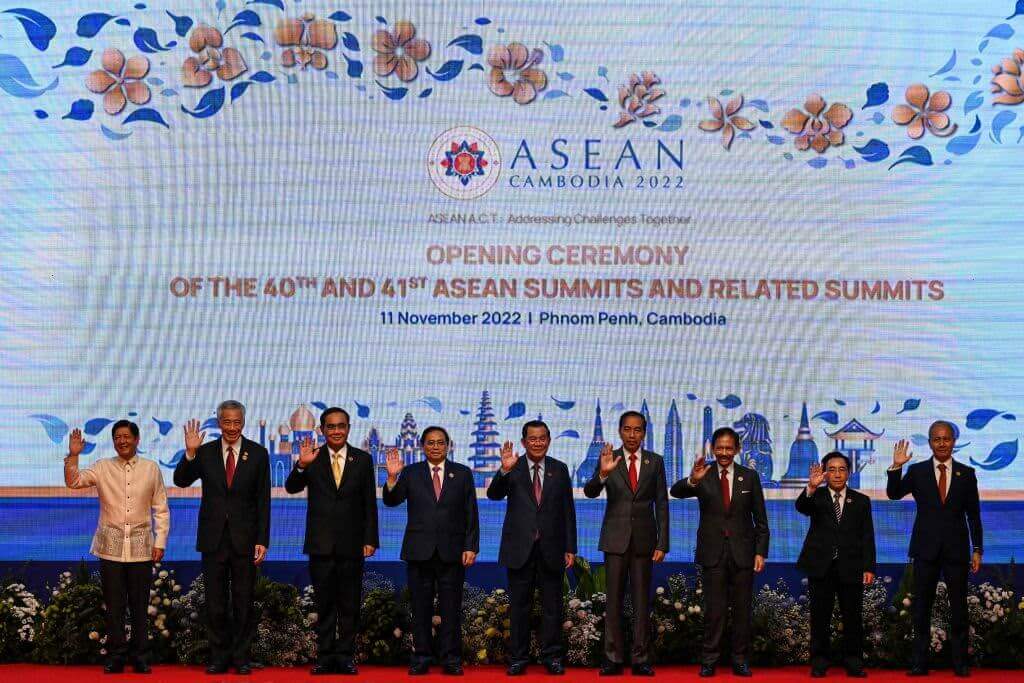Cambodia, the current chair of the Association of Southeast Asian Nations (ASEAN), hosted the 40th and 41st summit in Phnom Penh from Thursday to Sunday. Apart from post-pandemic recovery and Indo-Pacific, member countries discussed the political situation in Myanmar and Timor-Leste’s addition as the 11th member of the grouping.
Apart from ASEAN members (Brunei, Myanmar, Cambodia, Timor-Leste, Indonesia, Laos, Malaysia, the Philippines, Singapore, Thailand, and Vietnam), the event was also attended by ASEAN’s dialogue partners, which include India, Australia, New Zealand, the United Kingdom (UK), Canada, the United States (US), as well as China. ASEAN used the opportunity to upgrade its relationships and signed trade pacts with several of these countries.
India places great value on @ASEAN as an important pillar of regional, multilateral & global order.
— Vice President of India (@VPSecretariat) November 12, 2022
India supports the centrality of ASEAN in the evolving architecture in Indo-Pacific.
India & #ASEAN share a common vision in ensuring peace, prosperity & stability in the region. pic.twitter.com/SrgCEG9eW8
India
India’s delegation to the 19th ASEAN-India Summit was led by Vice President Shri Jagdeep Dhankhar and External Affairs Minister, S. Jaishankar. In a joint statement, the two sides announced the elevation of the existing Strategic Partnership to a Comprehensive Strategic Partnership.
They reaffirmed the importance of “promoting peace, stability, maritime safety and security, freedom of navigation and overflight” in the Indo-Pacific and also agreed to ensure “unimpeded lawful maritime commerce” and to “promote peaceful resolutions of disputes.”
I met Indian External Affairs Minister @DrSJaishankar on the margins of the @ASEAN summit today in Phnom Penh to discuss ongoing efforts to expand our partnership & mitigate the effects of Russia’s war on Ukraine. The U.S. supports India’s #G20 Presidency. #USIndiaAt75 pic.twitter.com/mLfzNOqJct
— Secretary Antony Blinken (@SecBlinken) November 13, 2022
Apart from this, both sides reaffirmed their commitment to collaborating on “counter-terrorism, transnational crimes, cyber security, digital economy, regional connectivity, smart agriculture, environment, science & technology, and tourism.”
In addition, they proposed “expediting the review” of their ASEAN-India Trade in Goods Agreement (AITIGA) to make it “more user-friendly, simple, and trade-facilitative.” They also vowed to expedite the operationalisation of the India-Myanmar-Thailand Trilateral Highway and laid out a vision to expand the project even further to Laos, Cambodia, and Vietnam as part of a wider goal of improving transport and connectivity across all domains.
19th ASEAN-India Summit pic.twitter.com/nz4os08hUK
— Bongbong Marcos (@bongbongmarcos) November 12, 2022
India expressed its support for ASEAN centrality in the “evolving regional architecture” and emphasised on the importance of cooperation via other regional frameworks, such as the Indian Ocean Rim Association (IORA), Bay of Bengal Initiative for Multi-Sectoral Technical and Economic Cooperation (BIMSTEC), Indonesia-Malaysia- Thailand Growth Triangle (IMT-GT), Singapore-Johor-Riau (SIJORI) Growth Triangle, Brunei Darussalam-Indonesia-Malaysia- Philippines East ASEAN Growth Area (BIMP-EAGA), Mekong-Ganga Cooperation (MGC), and Ayeyawady Chao Phraya-Mekong Economic Cooperation Strategy (ACMECS).
China
The two sides officially launched negotiations to upgrade the ASEAN-China Free Trade Area (ACFTA). The upgraded ACFTA will cover “areas of mutual interest,” including the digital economy, the green economy, supply chain connectivity, competition, consumer protection, and Micro, Small, and Medium Enterprises (MSMEs).
The agreement with China is ASEAN’s oldest FTA. The group said that its upgradation “sends a signal” to private as well as public stakeholders that both sides “are committed to make the ACFTA more relevant to businesses, future-ready, and responsive to global challenges.”
President Ferdinand R. Marcos Jr. on Sunday bared the consensus among Association of Southeast Asian Nations (ASEAN) members to support the One China Policy while urging China and Taiwan to resolve their dispute peacefully.
— Office of the Press Secretary (@opsgovph) November 13, 2022
READ: https://t.co/jxZRwu4qX8 pic.twitter.com/LbmZKFWG56
China is the Southeast Asian grouping’s largest trading partner and the second-largest source of Foreign Direct Investment (FDI) to the region. Last year, their total merchandise trade touched $669 billion, marking a 29% increase from the previous year, despite the COVID-19 pandemic’s “lingering impact.” The group further noted that during the same time period, FDI flows from China to ASEAN amounted to $13.6 billion, almost double the $7 billion figure from 2020.
New Zealand and Australia
Australia, New Zealand, and ASEAN announced the successful conclusion of negotiations to upgrade the ASEAN-Australia-New Zealand Free Trade Area (AANZFTA). According to ASEAN, the upgrade of the 2009 deal will ensure that the free trade agreement (FTA) is “future-proofed against emerging challenges.” It also aims to “remain relevant for businesses, enable it to effectively contribute to post-pandemic economic recovery efforts, and efficiently respond to global and regional challenges.”
Businesses on all sides are expected to benefit from the deal’s upgradation, as it will “improve transparency measures, lower costs and time for exports and imports, use of technological solutions for trade, (enhance) cooperation in digital technology, sustainable development, and education services, increase participation of micro, small, and medium enterprises in economic activities” and ensure the “smoother flow of essential goods during periods of crises.”
Great to see Australia 🇦🇺and New Zealand’s 🇳🇿continued efforts with our ASEAN partners in securing positive trade outcomes for trans-Tasman businesses. https://t.co/pMFpGSuyKm
— Harinder Sidhu (@AusHCNZ) November 14, 2022
Hailing the outcome, Australian Prime Minister Anthony Albanese said, “By upgrading AANZFTA, we hope to create new commercial opportunities for Australians, our exporters and investors to work hand-in-hand with ASEAN.” He added that the move would “cement Australia as a partner of choice in an open and inclusive region.”
Likewise, Minister for Trade and Tourism Senator Don Farrell noted that “Deeper economic integration with our key strategic and economic partners in Southeast Asia is a priority for the Australian Government.”
Similarly, ASEAN Secretary-General Lim Jock Hoi asserted that the upgrade was “a testament to the strength, durability and progressivity of an ASEAN-led regional economic architecture.”
Merchandise trade between Australia and Australia was recorded at $81.6 billion last year, a 49% increase from 2020. Meanwhile, merchandise trade with New Zealand reached $11 billion last year, a 22.5% increase from the previous year. FDI flows from the two countries to ASEAN also touched $589 million.

